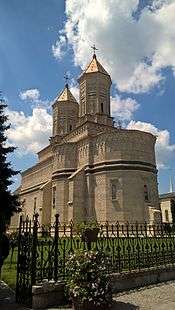Trei Ierarhi Monastery
| Trei Ierarhi Monastery Mănăstirea Trei Ierarhi | |
|---|---|
|
Trei Ierarhi Monastery Church | |
| Basic information | |
| Location | Iaşi |
| Affiliation | Romanian Orthodox |
| District | Metropolitan of Moldavia and Bukovina |
| State | Romania |
| Architectural description | |
| Architectural type | Moldavian |
| Groundbreaking | 1637 |
| Completed | 1639 |
| Materials | stone, brick |
Mănăstirea Trei Ierarhi (Monastery of the Three Hierarchs) is a seventeenth-century monastery located in Iaşi, Romania. The monastery is listed in the National Register of Historic Monuments[1] and included on the tentative list of UNESCO World Heritage Site.
History
-Trei_Ierarhi_Monastery_(J.Rey%2C_1845).jpg)
The church was erected between 1637 and 1639,[2] in the Moldavian capital, in honour of three saints (Basil of Caesarea, Gregory of Nazianzus, and John Chrysostom), and was blessed by Bishop Varlaam. In 1640, Prince Vasile Lupu, the renowned defender of the Orthodox Church, set up here the first printing press in Moldavia and the Vasilian College, a higher education institute. In 1643, the first volume ever printed in Moldavia was issued in Iași. The Trei Ierarhi Church was dedicated by Vasile Lupu to the 20 monasteries on Mount Athos.[3]
Several Romanian royal figures are buried inside the church: Tudosca (Vasile Lupu's first wife) and Ștefan Vodă, their son; prince and scholar Dimitrie Cantemir (1673–1723); and Alexandru Ioan Cuza, the first ruler of the united Romanian principalities (1859–1866).
Architectural features
The church became renowned for the extraordinary lacery in stone which adorns the facades, from bottom to the top of the derricks. One can count over 30 non-repeating registers of decorative motives. Western architectural elements (Gothic, Renaissance) combine with the Eastern style, of Armenian (Khachkar), Georgian, Persian, Arabian or Ottoman inspiration, in a totally bold conception, whose result is a harmonious ensemble.[1] The effusive scenery makes the church resemble a shrine of architectonic proportions, especially conceived to protect the Sfanta Cuvioasa Parascheva's relics (1641). After the 1882 restoration, the original fresco was derusted, some fragments still being kept today in the monastery's museum.
Near the church one can find the Gothic Hall, which shelters a religious art museum. It has, among other things, objects related to the history of the monastery. In the gate's tower (which today no longer exists), that served as belfry, Vasile Lupu had installed a huge horologe, the first public use clock in Romanian Principalities (1654).[1] During the 1882 restoration, the whole mechanism was disassembled and transported to France, where it remained.
See also
References
- 1 2 3 The Romanian Register of Historical Monuments in Iaşi County
- ↑ (Romanian) Ciprian Plaiașu, "Biserica 'Sfinţii Trei Ierarhi' din Iaşi: o reabilitare care nu se mai încheie", Adevărul, January 31, 2013; accessed February 6, 2013
- ↑ (Romanian) Florin Mihai, "Cum şi de ce s-a zidit Biserica 'Trei Ierarhi'", Adevărul, July 31, 2012; accessed September 3, 2012
- Aurelian Trişcu (1995). "The "Three Hierarchs" Church in Iaşi". ICOMOS- Journals of the German National Committee. pp. 93–97. Retrieved 2008-05-23.
- "The Church of the Trei Ierarhi Monastery". I.C.I. Bukarest. Archived from the original on 2008-03-07. Retrieved 2008-05-23.
External links
| Wikimedia Commons has media related to Trei Ierarhi Monastery. |
Coordinates: 47°9′35″N 27°35′5″E / 47.15972°N 27.58472°E
